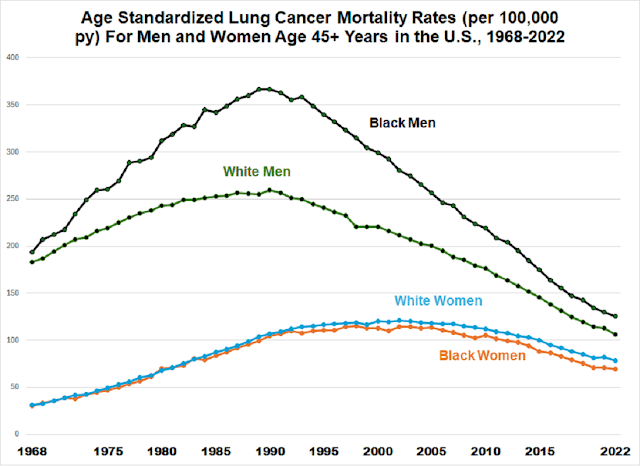
For years we have seen a battle over the banning of menthol
cigarettes. On one side are
prohibitionists, who believe that society’s ills can be cured by proscribing
specific behaviors and products.
Opposing a ban are libertarians and those civil rights advocates who
fear that prohibition would promote illegal sales and consumption, particularly
in the African-American community.
I have commented several times on who smokes menthols (here,
here,
here
and here);
this column was precipitated by a March 22 New York Times article
by Sheila Kaplan, “Menthol Cigarettes Kill Many Black People.”
The best way to look at smoking-related deaths is to examine
lung cancer mortality rates (LCMRs), expressed as deaths per 100,000 people per
year. The CDC Wonder website provides
tools for investigating deaths for the period 1968-2022, including
age-standardized rates, so that researchers can compare all of these years,
which had different population distributions.
The chart shows LCMRs for Black and White men and women in
the U.S. Keep in mind that these
mortality rates are latent with respect to smoking, stemming from smoking rates
20 years earlier. For example, when LCMRs
peaked for both Black and White men around 1990, that reflected high smoking
rates from around 1970.
The most striking finding here is that while the LCMR for
Black men was similar to that of White men in 1968, the rate for the former skyrocketed,
peaking in 1989-90 at 367. However,
after that, the rate plummeted every year except one. If menthol was the cause of smoking among
Black men, then it didn’t persist. By
2022, the LCMR among Black men was still higher than that among White men, but
the gap was much narrower.
It’s hard to specify menthol as a major factor, as the LCMR decline
was just as impressive as the LCMR increase.
If, as prohibitionists claim, menthol is easier
to start and harder
to quit,
we wouldn’t see this impressive reversal.
LCMRs were very similar among Black and White women until
around 2000, after which rates among White women were somewhat higher.
Also, note that LCMRs did not peak among women until over a
decade after they peaked among men, and women experience much more of a
plateau, from around 2000 to 2003. And we
still haven’t seen a sharp decline among women yet.
In 2012, FDA Center for Tobacco Products scientist Brian
Rostron published a study finding “evidence of lower lung cancer mortality risk
among menthol smokers compared with nonmenthol smokers at ages 50 and over in
the U.S. population.” (here). These results were in agreement with two
previous studies (here and here).
FDA officials consistently portray a menthol ban as a
corrective response to the tobacco industry’s presumptive targeting of
African-Americans. But, as I wrote
previously, far more Whites smoke menthol.
As for who has been “disproportionately impacted,” Black men have the
highest LCMRs of all four groups, but Black women have the lowest.




